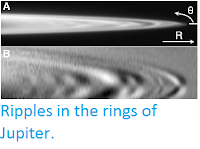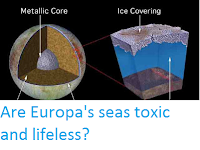The planet Jupiter will reach apihelion (the furthest point on its orbit
to the Sun) at 7.18 am GMT on Friday 17 February 2017, when it will be 5.454 92 AU (816 100 000 km) from the Sun. This is not actually a great
deal more distant than Jupiter's periphelion (closest point on its orbit from the
Sun), as Jupiter has one of the most circular orbit of any planet in our Solar
System, with its distance from the Sun varying by only 0.5 AU (74 800 000 km) over
the course of a Jovian Year; this is about half the distance between the Earth and the Sun, but less than 10% of Jupiter's average distance from the Sun.
Hubble Space Telescope image of Jupiter from October 2015. NASA.
Because Jupiter is considerably further from the Sun then the Earth, it's orbital period (year) is considerably longer, lasting 11.9 Earth years. This means that Jupiter will next reach perihelion on 20 January 2023 and aphelion on 28 December 2028.
The current position of Jupiter and the inner planerts. 'A' indicates the point of aphelion for each planet, and 'P' the point of perihelion. In The Sky.
See also...
Follow Sciency Thoughts on Facebook.








